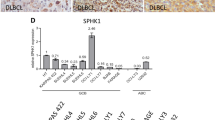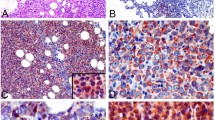Abstract
Deregulated expression of glycolytic enzymes contributes not only to the increased energy demands of transformed cells but also has non-glycolytic roles in tumors. However, the contribution of these non-glycolytic functions in tumor progression remains poorly defined. Here, we show that elevated expression of glyceraldehyde-3-phosphate dehydrogenase (GAPDH), but not of other glycolytic enzymes tested, increased aggressiveness and vascularization of non-Hodgkin’s lymphoma. Elevated GAPDH expression was found to promote nuclear factor-κB (NF-κB) activation via binding to tumor necrosis factor receptor-associated factor-2 (TRAF2), enhancing the transcription and the activity of hypoxia-inducing factor-1α (HIF-1α). Consistent with this, inactive mutants of GAPDH failed to bind TRAF2, enhance HIF-1 activity or promote lymphomagenesis. Furthermore, elevated expression of gapdh mRNA in biopsies from diffuse large B-cell non-Hodgkin’s lymphoma patients correlated with high levels of hif-1α, vegf-a, nfkbia mRNA and CD31 staining. Collectively, these data indicate that deregulated GAPDH expression promotes NF-κB-dependent induction of HIF-1α and has a key role in lymphoma vascularization and aggressiveness.
This is a preview of subscription content, access via your institution
Access options
Subscribe to this journal
Receive 12 print issues and online access
$259.00 per year
only $21.58 per issue
Buy this article
- Purchase on Springer Link
- Instant access to full article PDF
Prices may be subject to local taxes which are calculated during checkout









Similar content being viewed by others
References
Semenza GL . Targeting HIF-1 for cancer therapy. Nat Rev Cancer 2003; 3: 721–732.
Potente M, Gerhardt H, Carmeliet P . Basic and therapeutic aspects of angiogenesis. Cell 2011; 146: 873–887.
Kroemer G, Pouyssegur J . Tumor cell metabolism: cancer's Achilles' heel. Cancer Cell 2008; 13: 472–482.
Galluzzi L, Kepp O, Vander Heiden MG, Kroemer G . Metabolic targets for cancer therapy. Nat Rev Drug Discov 2013; 12: 829–846.
Lunt SY, Vander Heiden MG . Aerobic glycolysis: meeting the metabolic requirements of cell proliferation. Annu Rev Cell Dev Biol 2011; 27: 441–464.
Majewski N, Nogueira V, Bhaskar P, Coy PE, Skeen JE, Gottlob K et al. Hexokinase-mitochondria interaction mediated by Akt is required to inhibit apoptosis in the presence or absence of Bax and Bak. Mol Cell 2004; 16: 819–830.
Colell A, Ricci JE, Tait S, Milasta S, Maurer U, Bouchier-Hayes L et al. GAPDH and autophagy preserve survival after apoptotic cytochrome c release in the absence of caspase activation. Cell 2007; 129: 983–997.
Yang W, Xia Y, Ji H, Zheng Y, Liang J, Huang W et al. Nuclear PKM2 regulates beta-catenin transactivation upon EGFR activation. Nature 2011; 480: 118–122.
Luo W, Hu H, Chang R, Zhong J, Knabel M, O'Meally R et al. Pyruvate kinase M2 is a PHD3-stimulated coactivator for hypoxia-inducible factor 1. Cell 2011; 145: 732–744.
Jacquin MA, Chiche J, Zunino B, Beneteau M, Meynet O, Pradelli LA et al. GAPDH binds to active Akt, leading to Bcl-xL increase and escape from caspase-independent cell death. Cell Death Differ 2013; 20: 1043–1054.
Colell A, Green DR, Ricci JE . Novel roles for GAPDH in cell death and carcinogenesis. Cell Death Differ 2009; 16: 1573–1581.
Lavallard VJ, Pradelli LA, Paul A, Beneteau M, Jacquel A, Auberger P et al. Modulation of caspase-independent cell death leads to resensitization of imatinib mesylate-resistant cells. Cancer Res 2009; 69: 3013–3020.
Revillion F, Pawlowski V, Hornez L, Peyrat JP . Glyceraldehyde-3-phosphate dehydrogenase gene expression in human breast cancer. Eur J Cancer 2000; 36: 1038–1042.
Wang D, Moothart DR, Lowy DR, Qian X . The expression of glyceraldehyde-3-phosphate dehydrogenase associated cell cycle (GACC) genes correlates with cancer stage and poor survival in patients with solid tumors. PLoS One 2013; 8: e61262.
Harris AW, Pinkert CA, Crawford M, Langdon WY, Brinster RL, Adams JM . The E mu-myc transgenic mouse. A model for high-incidence spontaneous lymphoma and leukemia of early B cells. J Exp Med 1988; 167: 353–371.
Lindemann RK, Newbold A, Whitecross KF, Cluse LA, Frew AJ, Ellis L et al. Analysis of the apoptotic and therapeutic activities of histone deacetylase inhibitors by using a mouse model of B cell lymphoma. Proc Natl Acad Sci USA 2007; 104: 8071–8076.
Beneteau M, Zunino B, Jacquin MA, Meynet O, Chiche J, Pradelli LA et al. Combination of glycolysis inhibition with chemotherapy results in an antitumor immune response. Proc Natl Acad Sci USA 2012; 109: 20071–20076.
Dayan F, Roux D, Brahimi-Horn MC, Pouyssegur J, Mazure NM . The oxygen sensor factor-inhibiting hypoxia-inducible factor-1 controls expression of distinct genes through the bifunctional transcriptional character of hypoxia-inducible factor-1alpha. Cancer Res 2006; 66: 3688–3698.
Bottero V, Imbert V, Frelin C, Formento JL, Peyron JF . Monitoring NF-kappa B transactivation potential via real-time PCR quantification of I kappa B-alpha gene expression. Mol Diagn 2003; 7: 187–194.
Garaulet G, Alfranca A, Torrente M, Escolano A, Lopez-Fontal R, Hortelano S et al. IL10 released by a new inflammation-regulated lentiviral system efficiently attenuates zymosan-induced arthritis. Mol Ther 2013; 21: 119–130.
Campo E, Swerdlow SH, Harris NL, Pileri S, Stein H, Jaffe ES . The 2008 WHO classification of lymphoid neoplasms and beyond: evolving concepts and practical applications. Blood 2011; 117: 5019–5032.
project TIN-Hslpf. A predictive model for aggressive non-Hodgkin's lymphoma. The International Non-Hodgkin's Lymphoma Prognostic Factors Project. N Engl J Med 1993; 329: 987–994.
Thieblemont C, Briere J, Mounier N, Voelker HU, Cuccuini W, Hirchaud E et al. The germinal center/activated B-cell subclassification has a prognostic impact for response to salvage therapy in relapsed/refractory diffuse large B-cell lymphoma: a bio-CORAL study. J Clin Oncol 2011; 29: 4079–4087.
De Bock K, Georgiadou M, Schoors S, Kuchnio A, Wong BW, Cantelmo AR et al. Role of PFKFB3-driven glycolysis in vessel sprouting. Cell 2013; 154: 651–663.
Le A, Lane AN, Hamaker M, Bose S, Gouw A, Barbi J et al. Glucose-independent glutamine metabolism via TCA cycling for proliferation and survival in B cells. Cell Metab 2012; 15: 110–121.
Gao X, Wang X, Pham TH, Feuerbacher LA, Lubos ML, Huang M et al. NleB, a bacterial effector with glycosyltransferase activity, targets GAPDH function to inhibit NF-kappaB activation. Cell Host Microbe 2013; 13: 87–99.
Adams JM, Harris AW, Pinkert CA, Corcoran LM, Alexander WS, Cory S et al. The c-myc oncogene driven by immunoglobulin enhancers induces lymphoid malignancy in transgenic mice. Nature 1985; 318: 533–538.
Lossos IS, Alizadeh AA, Diehn M, Warnke R, Thorstenson Y, Oefner PJ et al. Transformation of follicular lymphoma to diffuse large-cell lymphoma: alternative patterns with increased or decreased expression of c-myc and its regulated genes. Proc Natl Acad Sci USA 2002; 99: 8886–8891.
Lenz G, Wright G, Dave SS, Xiao W, Powell J, Zhao H et al. Stromal gene signatures in large-B-cell lymphomas. N Engl J Med 2008; 359: 2313–2323.
Jones RG, Thompson CB . Tumor suppressors and cell metabolism: a recipe for cancer growth. Genes Dev 2009; 23: 537–548.
Altenberg B, Greulich KO . Genes of glycolysis are ubiquitously overexpressed in 24 cancer classes. Genomics 2004; 84: 1014–1020.
Chang CH, Curtis JD, Maggi LB Jr, Faubert B, Villarino AV, O'Sullivan D et al. Posttranscriptional control of T cell effector function by aerobic glycolysis. Cell 2013; 153: 1239–1251.
Kim JW, Zeller KI, Wang Y, Jegga AG, Aronow BJ, O'Donnell KA et al. Evaluation of myc E-box phylogenetic footprints in glycolytic genes by chromatin immunoprecipitation assays. Mol Cell Biol 2004; 24: 5923–5936.
Claeyssens S, Gangneux C, Brasse-Lagnel C, Ruminy P, Aki T, Lavoinne A et al. Amino acid control of the human glyceraldehyde 3-phosphate dehydrogenase gene transcription in hepatocyte. Am J Phys Gastrointest Liver Physiol 2003; 285: G840–G849.
Mookherjee N, Lippert DN, Hamill P, Falsafi R, Nijnik A, Kindrachuk J et al. Intracellular receptor for human host defense peptide LL-37 in monocytes. J Immunol 2009; 183: 2688–2696.
Rodriguez-Pascual F, Redondo-Horcajo M, Magan-Marchal N, Lagares D, Martinez-Ruiz A, Kleinert H et al. Glyceraldehyde-3-phosphate dehydrogenase regulates endothelin-1 expression by a novel, redox-sensitive mechanism involving mRNA stability. Mol Cell Biol 2008; 28: 7139–7155.
Zhou Y, Yi X, Stoffer JB, Bonafe N, Gilmore-Hebert M, McAlpine J et al. The multifunctional protein glyceraldehyde-3-phosphate dehydrogenase is both regulated and controls colony-stimulating factor-1 messenger RNA stability in ovarian cancer. Mol Cancer Res 2008; 6: 1375–1384.
Endo A, Hasumi K, Sakai K, Kanbe T . Specific inhibition of glyceraldehyde-3-phosphate dehydrogenase by koningic acid (heptelidic acid). J Antibiot 1985; 38: 920–925.
Sakai K, Hasumi K, Endo A . Identification of koningic acid (heptelidic acid)-modified site in rabbit muscle glyceraldehyde-3-phosphate dehydrogenase. Biochim Biophys Acta 1991; 1077: 192–196.
Acknowledgements
We gratefully acknowledge the Centre Méditerranéen de Médecine Moléculaire animal and microscopy facilities. We thank Drs Tanti JF, Cormont M and Giorgetti-Peraldi S for the hypoxic chamber, Larbret F for cell sorting, Dr Pouysségur J for HIF-1α antibody, Escoubas C, Paquet A and Barbry P for their help. Acknowledgement to the Tumorothèque of Hopital Saint-Louis for the preparation of the tumoral samples of the patients. This work was supported by the Fondation ARC (Association pour la Recherche sur le Cancer), the Agence Nationale de la Recherche (ANR-09-JCJC-0003, LABEX SIGNALIFE ANR-11-LABX-0028-01), by la Fondation de France, the Centre Scientifique de Monaco and the Cancéropole PACA. JC was supported by the Fondation ARC and by la Fondation de France. LM was supported by Fondation pour la Recherche Medicale (FRM) and la Ville de Nice.
Author information
Authors and Affiliations
Corresponding author
Ethics declarations
Competing interests
The authors declare no conflict of interest.
Additional information
Supplementary Information accompanies this paper on the Leukemia website
Rights and permissions
About this article
Cite this article
Chiche, J., Pommier, S., Beneteau, M. et al. GAPDH enhances the aggressiveness and the vascularization of non-Hodgkin’s B lymphomas via NF-κB-dependent induction of HIF-1α. Leukemia 29, 1163–1176 (2015). https://doi.org/10.1038/leu.2014.324
Received:
Revised:
Accepted:
Published:
Issue Date:
DOI: https://doi.org/10.1038/leu.2014.324
This article is cited by
-
The TRAF2-p62 axis promotes proliferation and survival of liver cancer by activating mTORC1 pathway
Cell Death & Differentiation (2023)
-
Hypoxia-specific imaging in patients with lymphoma undergoing CAR-T therapy
European Journal of Nuclear Medicine and Molecular Imaging (2023)
-
Amelioration for an ignored pitfall in reference gene selection by considering the mean expression and standard deviation of target genes
Scientific Reports (2022)
-
Hypoxia-induced lncRNA PDIA3P1 promotes mesenchymal transition via sponging of miR-124-3p in glioma
Cell Death & Disease (2020)
-
Pleiotropic effects of moonlighting glyceraldehyde-3-phosphate dehydrogenase (GAPDH) in cancer progression, invasiveness, and metastases
Cancer and Metastasis Reviews (2018)



